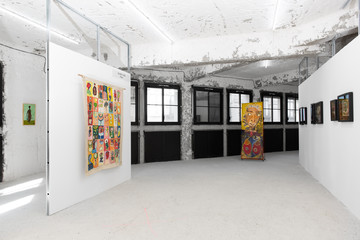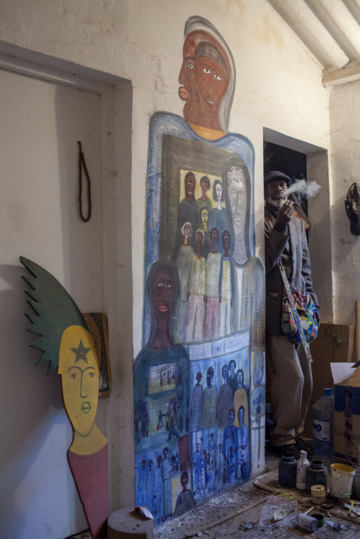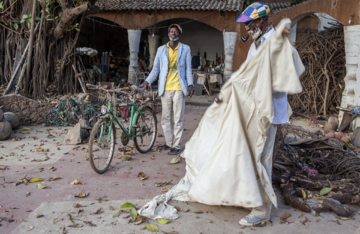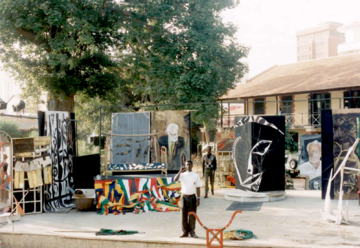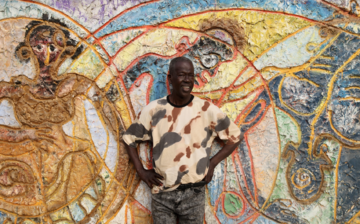Alioune Diouf
b.1964, Dakar, Senegal
From Zoomorphic creatures, androgynous silhouettes to references to historical figures in Senegalese society such as the Signares or the Baye Fall, Alioune Diouf’s work evoke ancient cosmogonies and traditional forms of ecologies. Using textile scraps and embroidery, his pictorial universe is characterized by the intermingling of characters, animals, cosmic and floral motifs and by a spiritual and sacred symbolism influenced by his Serer origins, Egyptian art or Ethiopian frescoes. Often evoking the cycles of life, his work is invested with a layer of symbols - the egg, the moon, the cross - whose iconographic reading touches on various cultural, religious and historical beliefs. Evoking the cycle of life, he dialogues with philosophies of the ancients (notably the Serer ethnic group culture) who saw their natural environment as source of knowledge.
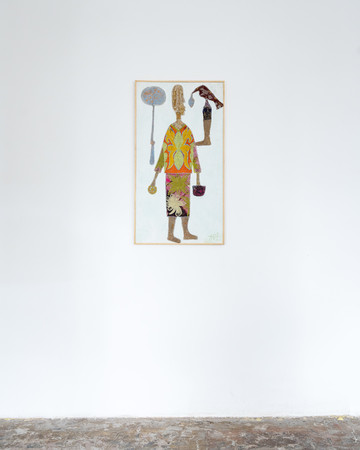
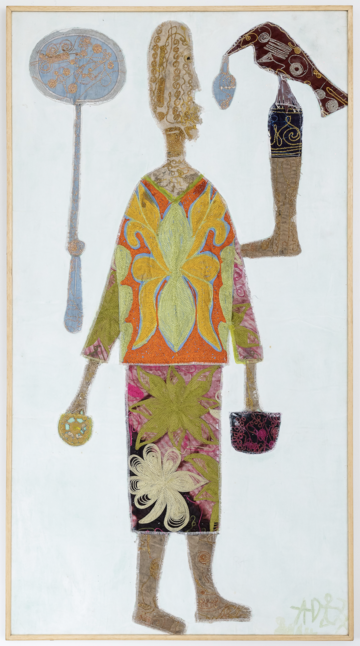
Acrylic and embroidery on textile
97 x 53 CM
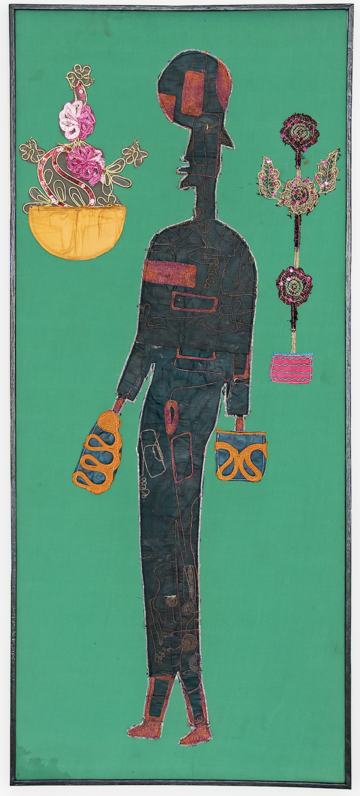
Embroidery on textile
110x48 CM
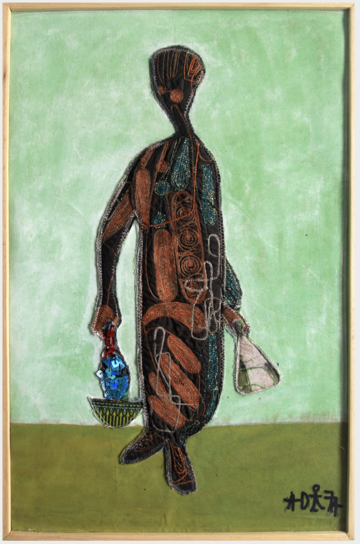
Acrylic and embroidery on textile mounted on canvas
54 x34 CM
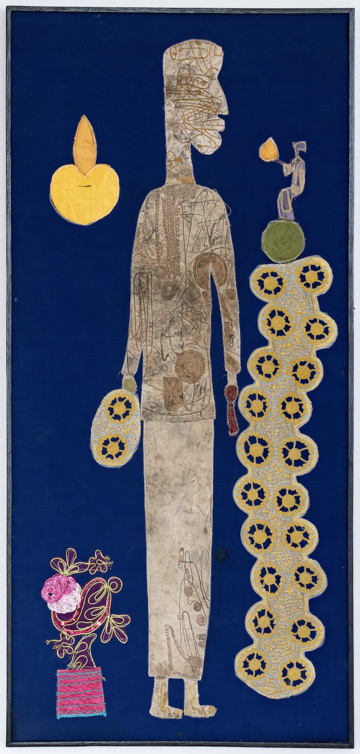
Embroidery on textile
111x52 CM
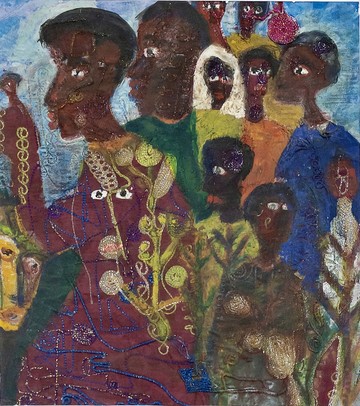
Acrylic and embroidery on canvas
50 x51 CM (with black frame)
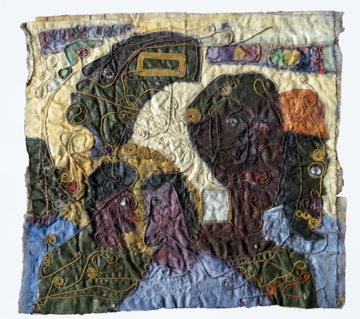
Acrylic and embroidery on textile
46x52CM (with black frame)
Alioune Diouf in Le Laboratoire Agit’Art Courtyard with Issa Samb
Credit: Bastien Desfives
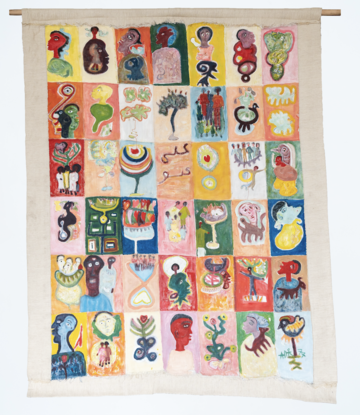
Alioune Diouf (b. 1964, Dakar) lives and works in Dakar. Of Serer origins, he pursued a koranic education while his artistic education happened outdoor in direct observations of the world and in contact with a large community of artists. A member of the historical artist collective le Laboratoire Agit’ Art, Alioune Diouf has worked alongside key artistic figures such as Issa Samb (aka Joe Ouakam). In 2020, Alioune Diouf had his first major solo exhibition entitled “Ubeku” at Selebe Yoon Gallery, Dakar, Senegal (2020) following a two month residency. His work was included in several group exhibitions: “Sur le Fil”, le19M, Paris, France; “Teg Bët Gëtstu Gi” at the Theodore Monod Museum (IFAN), during the Dak’art Biennale, co-organized by art historian Emmanuelle Chérel (2022); “Tant que les arbres s’enracineront dans la Terre”, at the French Embassy, Dak’Art Biennale, (2022); “How to talk with birds, trees, fish, shells, snakes, bulls and lions” in collaboration with Issa Samb at the Hamburger Bahnof Museum, Berlin (2019). Through the Laboratoire Agit’Art, he participated at numerous exhibitions, namely Le Congrès de Minuit (Dakar biennial, OFF, 2016) and La Cloche des Fourmis (Biennale de Dakar, OFF, 2018). His work is in important public collections such as the Beaux-Arts de Nantes (France) and Maison des Esclaves, Gorée (Senegal) as well as numerous private collections across the USA, Europe and Africa such as Jom Collection, Senegal.
El Hadji Sy
(b.1954, Dakar, Senegal)
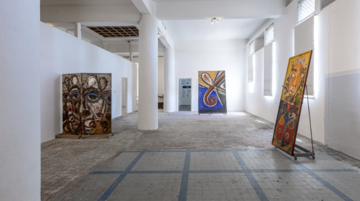
As a multidisciplinary artist, cultural activist, curator and art historian, El Hadji Sy (born
in Dakar, 1954) is one of the pioneering artists of Senegal in the post-independence
period and is one of the founders of Africa’s most important artist collective founded in
1974 - Le Laboratoire Agit’Art. Upon graduating from the school of Beaux-Arts in 1977 in
Dakar, he remained defiant towards state cultural policy and the aesthetics principles of
the negritude - yet he received the support and admiration of former president Leopold
Sedar Senghor with whom he exchanged and confronted with continuously.
El Hadji Sy combines his painting with political activism and curatorial practice.
Mobile like props on a stage, semi-functional, blurring the boundaries between functionality and
aesthetics, his works metamorphose into paravents, doors, windows and itinerant
structures. From poetic interpretations of political phenomenon, renderings of daily
scenes, allusive portraits of political, intellectual, mythological or ordinary figures, his
paintings play on the notion of “glissement” (sliding) of identity, narratives, characters
and create overlaps between legendary tales and ordinary news. Both figurative and
abstract, they convey a visual musicality whereby the bodies and forms
submit to a permanent undulatory rhythm.
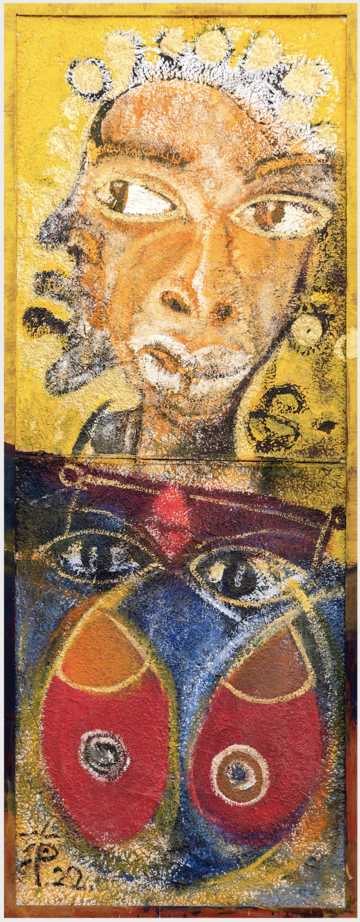
Acrylic on papier mâché
212 x 76,5 CM
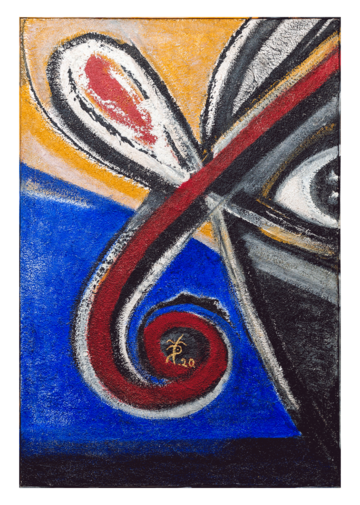
Acrylic, tar, papier mâché
mounted on canvas
254 x 151 CM
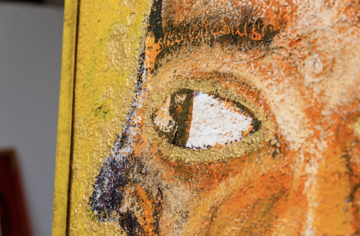
El Hadji Sy (born in Dakar, 1954) is one of the pioneering artists of Senegal in the postindependence period and is one of the founders of Africa’s most important artist collective founded in 1974 - Le Laboratoire Agit’Art. Internationally, his work has been exhibited in numerous institutions such as the Museum of Fine Arts, Boston (1980); Linda Goodman Gallery, Johannesburg, (1995); Documenta 14, Kassel (2017); U-jazdowski Castle Center for Contemporary Art, Warsaw (2016); the National Gallery, Prague (2016); the Sao Paulo Biennal (2015); Blum & Poe Gallery, Los Angeles (2020); Kunstverein, Hamburg (2021), amongst others. The artist received a major retrospective Painting, Performance, Politics curated by the artist together with Clémentine Deliss, Yvette Mutumba and Philippe Pirotte at the Weltkulturen Museum in 2015 for which objects from the museum’s ethnographic collection, selected by the artists, were placed in dialogue with his work. In Dakar, he is one of the only senegalese artists to exhibit at the Musée Dynamique in 1966, following Pablo Picasso (1972) and Pierre Soulages (1974). El Hadji Sy worked with numerous curators namely Clementine Deliss, Hans-Ulrich Obrist, Alison Gingerich, and Peter Pakesch. His work is held in a number of important collection - Weltkulturen Museum (Allemagne), la Fondation Blachère (France), David Bowie (USA), Bassam Chaitou (Sénégal), Kehinde Wiley (USA/ Sénégal), Jean Loup Pivin (France).
As a cultural activist, El Hadji Sy has always been involved in the development of art and culture of his country through collective
initiatives in Dakar through the founding of artists studio complex and collectives such as Tenq and Huit Facettes. He published on
this occasion the first anthology of the arts of Senegal, prefaced by Léopold Sédar Senghor in 1989. In 1995, he was invited by Clémentine Délisse to co-curate the exhibition “Seven Stories about Modern Art in Africa” at the Whitechapel Gallery during Africa95 festival. Despite having travelled and exhibited internationally, El Hadji Sy has always been working and living in Dakar, Senegal.

